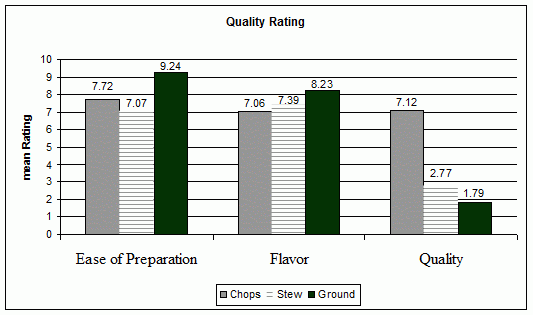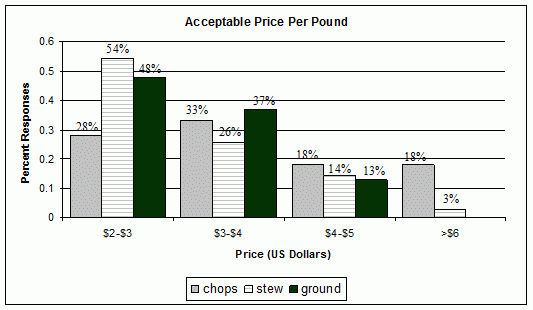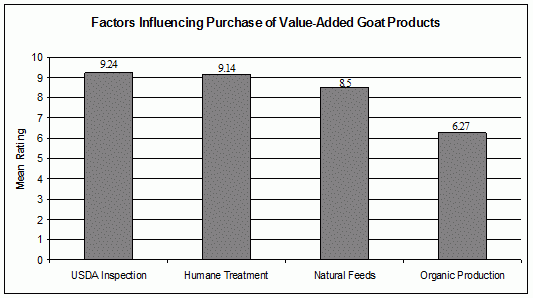Journal of the NACAA
ISSN 2158-9429
Volume 3, Issue 2 - December, 2010
Determining Consumer Acceptance of Value-Added Meat Goat Products in New Jersey
- Komar, S.J., Agricultural and Natural Resources Management Agent, Rutgers Cooperative Extension
Mickel, R., Agriculture and Resource Management Agent, Rutgers Cooperative Extension
ABSTRACT
A study was conducted to determine the feasibility of marketing processed goat meat products to New Jersey consumers and to determine if goat production was a viable enterprise for small-scale producers. Thirteen percent reported that they would purchase goat meat once a week, while more than 50 percent reported that they would purchase once every month. More consumers reported a willingness to pay a premium for the chops than the stew meat and ground. USDA inspection and humane treatment were the most important factors influencing purchase decisions. Meat goat production appears to be a viable enterprise for small-scale livestock producers.Introduction
Domestic demand for goat meat is among the highest in the northeast region of the United States. Much of the demand for meat goats traditionally comes from myriad ethnic groups with large populations in the northeast. Pinkerton et al. (1995) estimated a majority of immigrants who settled in the northeastern United States are meat goat consumers. New Jersey ranks the highest in the region with thirty-seven percent of all goats slaughtered domestically occurring in the state. In 2006, more than 566,000 meat goats were harvested in the United States of which, 209,156 were harvested in New Jersey (NASS, 2006 Livestock Summary). Although the demand for goat meat in the northeast is well documented (Knudson, 2006, Gipson, 2007) very little research and extension programming has been conducted to evaluate the feasibility of marketing fabricated products. The existing high demand for goat meat in the northeast, combined with the high number of small-scale farming operations in the region, makes meat goat production a potentially viable alternative for small farms. In order for this enterprise to be successful, producers will require significant education in various aspects of goat production including marketing, animal husbandry, among others. These educational needs fit well within the traditional programming of Cooperative Extension.
Extension Programming
Program planning and development is central to the educational mission of Cooperative Extension. Prior to committing resources to the development of a full scale extension program focusing on value-added meat goat production a team of extension personnel was assembled. The team was assembled to clarify and develop goals, strategies and action steps of the program. The study team identified some core questions that needed to be addressed. First, was the demand for goat meat primarily confined to certain ethnic groups? Also, could the market for meat goat products be expanded to consumers in general? If the market for meat goat products expanded could small farm producers in New Jersey help to meet this demand? In 2007, Cooperative Extension, initiated a study to first, determine the economic suitability and feasibility of raising meat goats in New Jersey and second, to determine if consumers would purchase fabricated goat meat products regularly. The production study (data not shown) demonstrated that meat goat production could be economically feasible on small farms provided that consumers would be willing to pay a premium for locally-raised products. Since little research has been conducted to evaluate consumer acceptance of fabricated goat products, an organoleptic study was also initiated in 2007.
Methods
In order to quantify consumer acceptance of meat goat products, seventy evaluators were selected to participate in this study. Participants were solicited using Rutgers University e-mail distribution lists, personal contacts and word-of-mouth advertising. Participants were provided with three products fabricated from goats harvested in the meat goat production study.
Products included one pound of ground goat meat, four chops (loin and rib chops) and two pounds of stew meat. Products were processed in accordance with USDA guidelines, individually shrink-wrapped, labeled and frozen. Each participant was asked to prepare identical recipes and complete a survey after the recipes were sampled.
The survey consisted of both close-ended questions with blank spaces for respondents to write additional comments. Participants were asked to rate each product for selected qualitative characteristics (1= poor, 10 = excellent) including ease of preparation, flavor, and overall quality. Respondents were asked to quantify the price range they would be willing to pay for each product and estimate how often they would purchase the product.
Participants were then asked to rate the importance of a series of marketing components such as USDA certification, organic production, and humane treatment and to determine how these factors would impact their purchasing decisions. The survey questions reported in this study are listed below.
Survey Questions
1. Have you eaten goat meat before this study? (Yes or No)
2. Please rate the following characteristics for each of the cuts (1= poor, 10 = excellent).
Ease of Preparation
· Stew 1 2 3 4 5 6 7 8 9 10
· Chops 1 2 3 4 5 6 7 8 9 10
· Ground 1 2 3 4 5 6 7 8 9 10
Flavor
· Stew 1 2 3 4 5 6 7 8 9 10
· Chops 1 2 3 4 5 6 7 8 9 10
· Ground 1 2 3 4 5 6 7 8 9 10
Overall Quality
· Stew 1 2 3 4 5 6 7 8 9 10
· Chops 1 2 3 4 5 6 7 8 9 10
· Ground 1 2 3 4 5 6 7 8 9 10
3. How much would you be willing to pay per pound for each product?
Stew ($2-$3) ($3-$4) ($4-$5) ($6+)
Chops ($2-$3) ($3-$4) ($4-$5) ($6+)
Ground ($2-$3) ($3-$4) ($4-$5) ($6+)
4. If this product were available on a regular basis would you purchase it?
(Yes or No)
Yes No
a. Stew ___ ___
b. chops ___ ___
c. Ground ___ ___
5. How often would you purchase meat goat products, if available?
a. Once a month
b. Once a week
c. Two or more times a year
d. Other
6. How important are the following items when making your purchasing decisions (1 = not important, 10 = very important)?
USDA inspection 1 2 3 4 5 6 7 8 9 10
Quality assurance 1 2 3 4 5 6 7 8 9 10
Natural feeds 1 2 3 4 5 6 7 8 9 10
Hormone free 1 2 3 4 5 6 7 8 9 10
Custom cut 1 2 3 4 5 6 7 8 9 10
Source identified 1 2 3 4 5 6 7 8 9 10
Delivery available 1 2 3 4 5 6 7 8 9 10
Ethnic processing 1 2 3 4 5 6 7 8 9 10
Organic production 1 2 3 4 5 6 7 8 9 10
A modified Dilman (1978) survey methodology was followed with an initial survey being mailed followed by a reminder card three weeks after the original deadline. Responses were aggregated for analysis and means quantified using the means procedure (SAS Institute, 2008).
Findings
The survey response rate was 84 percent (n = 59). Among respondents, 59 percent were male, 41 percent were female. Nearly two-thirds (63 percent) of the respondents reported never eating goat meat before participating in the trial. Respondents rated ground goat higher for flavor with an average rating of 8.23 (95% CI, 7.92-8.53). Participants rated the flavor of stew 7.39 (95% CI, 6.70- 8.08) slightly higher than the chops with a mean rating of 7.06 (95% CI, 6.40-7.71).
When rated for ease of preparation, consumers consistently rated the ground meat very high resulting in a mean rating of 9.24 (95% CI, 8.88-9.59). More variability was observed among ratings for the chops (mean rating=7.72, 95% CI, 7.20-8.23) and the stew meat (mean rating=7.07, 95% CI, 6.31-7.82 ). This variation may be explained by the tendency of respondents who rated the product lower to report increased preparation time resulting from de-boning stew meat and trimming the chops. Similar responses were reported when each of the cuts was rated for over-all quality. The ground meat was consistently rated higher with a mean rating of 8.43 (95% CI, 7.97-8.88) than both the chops which consumers rated 7.12 (95% CI, 6.55-7.68) and the stew meat which consumers rated 6.55 (95% CI, 5.84-7.25) (figure 1.).
Figure 1.
Consumer Ratings of Selected Quality Characteristics (n=59).

A majority of respondents 83 percent (n = 50) indicated they would purchase ground goat meat. This was higher than both the chops (59 percent, n = 49) and the stew meat (52 percent, n = 52). Thirteen percent of respondents reported they would purchase goat meat once a week, while more than 50 percent reported they would purchase at least once every month.
Differences were observed in the average price participant’s were willing to pay for each product. Among respondents, less than 3 percent reported they would pay a premium price (> $6 per pound) for the stew meat with the majority (54 percent) indicating a willingness to pay between $2-$3 per pound (figure 2.). Respondents were more willing to pay a premium price for the chops (18 percent) with 51 percent reporting a willingness to pay $3-$5 per pound. Although participants rated the ground meat higher for all parameters in the study, none reported a willingness to pay a premium price. Among respondents, 13 percent reported a willingness to pay $4-$5 per pound with the majority (85 percent) reporting a willingness to pay $2-$4.
Figure 2.
Consumer’s Reported Willingness to Purchase Meat Goat Products at
Various Price Points (n=59).

USDA inspection was the most important factor influencing consumer’s decision to purchase (figure 3.) with a mean rating of 9.24 (95% CI, 8.87-9.60). Humane treatment was also important with a mean rating of 9.14 (95% CI, 8.72-9.55).
Figure 3.
Influence of Select Production Factors on Consumer Tendencies (n=59) to Purchase Meat Goat Products (1= Not Important, 10= Very Important).

Conclusions
Based on consumer acceptance of meat goat products, meat goat production appears to be a viable option for New Jersey producers. The fact that nearly two-thirds of individuals surveyed have not eaten meat goat products before the taste test suggests the potential to develop this market further. Initial results suggest that the production of a value-added meat goat product may provide an opportunity to enhance profitability particularly for small-scale producers. In order for these marketing opportunities to be further quantified, more comprehensive consumer research is needed to determine optimal cuts, develop marketing strategies, pricing structure and product placement. Other production factors such as animal supply, production costs, and management regimes need to be investigated. The development of small-scale, value added markets fits well within the New Jersey Agricultural Experiment Station mission. Future programming efforts will continue to focus on both small-scale production models and value-added production of meat goat and other livestock species.
References
Dilman, D.A. (1978). Mail and telephone surveys: The total design. John Wiley & Sons, New York
Gipson, T.A. (2001). Demand for goat meat: implications for the future of the industry. Langston University, E(Kika) de LaGarza Institute for Goat Research, Langston, OK.
Knudson, K.A. (2006) Market opportunities for meat goats. The Strategic Marketing Institute Working Paper, No. 2-0106. East Lansing: Michigan State University, Product Center for Agriculture and Natural Resources.
Pinkerton, F. (1995). Meat goat marketing in greater New York City. Final Report of the Center for Agricultural Development and Entrepreneurship to USDA-Agricultural Marketing Service Federal-State Market Improvement Program, Washington, DC.
SAS Institute Inc. (2004). SAS/STAT 9.1 Users Guide, Cary, NC: SAS Institute Inc.
U.S. Department of Agriculture, National Agricultural Statistics Service. Livestock
